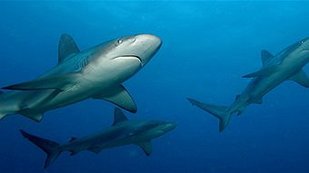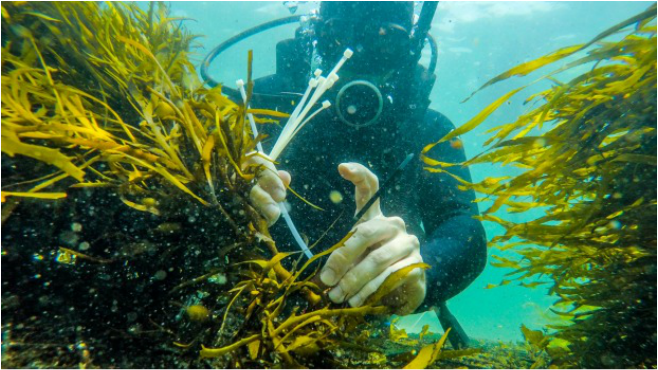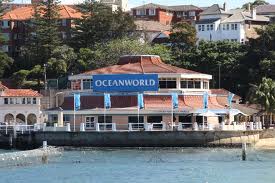 It doesn’t look like a fir tree, and you can’t wrap it with tinsel, but an underwater Christmas tree would be a great choice this holiday season. The idea comes from University of NSW scientists who are working to restore the seaweed forests that disappeared from Sydney’s coastline 30 years ago. Their plan is to crowdfund the work by inspiring people to sponsor individual “trees” that will be planted onto deforested underwater reefs. The disappearance of the once-thriving seaweed trees – crayweed (Phyllospora comosa) – is thought to be linked to the discharge of poorly treated sewage close to Sydney beaches in the 1970s and ‘80s. The Manly community led that fight with its famous POOO - People Opposed to Ocean Outfall - marches, and our water is much cleaner as a result. However, the crayweed colonies have not regrown. That’s where “Operation Crayweed” comes in. UNW scientists use fertile adult crayweed plants, which they “plant” in a biodegradable mesh attached to reefs about 2 to 3 metres down. The method has already created new, self-sustaining crayweed colonies at test sites at Cape Banks, Little Bay and Long Bay, and researchers are now ready to scale the project up and bring crayweed back to a 70km-long stretch of coastline between Palm Beach and Cronulla. It’s important because seaweeds are the “trees of our oceans, providing habitat, food and shelter for other marine organisms,” said UNSW marine ecologist Dr Adriana Verges. “When these forests disappear, it’s a sign that something has gone fundamentally wrong and diverse marine communities and economically important species such as rock lobsters and abalone disappear too.” It’s $20 to sponsor one tree, $50 for a little crayweed family that can reproduce on its own or $500 to plant a whole forest. Your Christmas tree won’t be on its lonesome. "We have been extremely humbled by the amazing response!" Dr Verges said. "We reached our original $20,000 target in only five days! We had planned to restore four sites, but we are now raising the bar and hoping we can raise enough to restore six or perhaps even eight sites. That would mean reaching $40,000 by January 31." To help visit the Operation Crayweed display at Manly Sea Life Sanctuary or go to pozible.com/project/202503
0 Comments
 A circling shark fin is every swimmer's worst nightmare, and the recent death of surfer Zac Young near Coffs Harbour has refocused our emotions on the danger that lurks beneath. But are we really at risk? And if we are, do shark nets - our current shark prevention strategy - actually work? Shark meshing off Sydney's beaches was introduced in 1937 following a series of fatal shark attacks, including several on the Northern Peninsula. Most people think the nets are to stop sharks reaching popular beaches, but that's not true. The nets are there to kill sharks - specifically big (two metre long) sharks. Not only is this a controversial practice at a time when we are trying to protect Australia's declining shark population, but the nets kills a huge number of other marine creatures as well. Late last month, a whale calf drowned after it became entangled in a shark net off Mona Vale Beach. And so far this season, six whales have been caught, and luckily rescued, from shark nets off Queensland. Added up over several years, the carnage is sickening. Over the last 20 years almost 4000 sea creatures have been caught in shark nets off the NSW coast alone. Of these, less than 150 were "target" species - great white or tiger sharks. A massive 96 per cent of deaths were "bycatch" - giving a total of 3795 dead dolphins, turtles, whales, seals, stingrays, penguins, dugongs and harmless sharks. In a further irony it's reported that 35 - 50 per cent of sharks caught in the nets are on the beach side. However the meshing program, which is run by the NSW Department of Primary Industries, has plenty of defenders. Most point to the fact that there has only been one fatal shark attack in the meshed area, which includes beaches from Newcastle to Wollongong, since the program began. And that's despite the huge popularity of our part of the coast, which is enjoyed by 2 million people every summer season. But Dave Thomas, founder of local conservation group Eco Divers, isn't buying. "The risk of having a shark encounter is infinitesimally small," he said. "There are five fatalities in the world per year. There are a lot of things that will get you before that - hippos, vending machines, coconuts." Mr Thomas says the nets, which are 150m long, six metres high and sit in 10-12m of water, are by no good as a barrier as sharks can swim around or over them. What the nets do do well, is act as "indiscriminate killers of everything". He has the support of Surf Life Saving NSW which, along with marine ecologists and environmental and animal welfare groups, is calling for more research into alternative shark protection measures. Ideas already on the table include radio signals, sonar technology, electric nets and swimmer education. There's no debate that swimmers should avoid swimming at dusk, dawn or in murky water. They should also stay out of the water when schools of bait fish are about, to avoid being accidentally bitten by a shark in a "feeding frenzy". As well, shark nets were introduced in an era when our coastal waters were often dirty and sometimes contaminated with offal and blood, which meatworks used to dispose of in public waterways. The situation is so different now, surely our swimmer safety approach should change too. Good For Manly supports research into alternatives to shark meshing. In the meantime we believe the shark mesh season should be shortened. The nets are currently in place between September 1 and April 30, which overlaps the whale migration season from late April to November. This is our debate. There are shark nets off Queenscliff, North Steyne and Manly. Let us know what you think. Help us take a fair shark net proposal to Manly Council early next year. Great news! The new owners of Oceanworld Manly are making major changes. From June 28th it will be known as the Manly Sea Life Sanctuary. Over the coming weeks, the Sanctuary will be preparing for its new role as a “world class facility for the breeding, protecting, rescue and rehabilitation of Australian marine life.”
At the core of the relaunch is the Penguin Cove, which will give visitors a chance to see Manly’s famous Little Penguins (a great initiative!) while learning about how they can help protect these iconic birds, and a new rehabilitation facility to care for sick and injured animals. You can read more here. What do you think of the new plans for Oceanworld/Manly Sea Life Sanctuary? |
AuthorCandy Bingham, Deputy Mayor & Manly Ward Councillor on Northern Beaches Council. Background in marketing, public relations and community engagement. Author of five business books. Former Lady Mayoress of Sydney. Aka Candy Tymson. ........................................
View Videos
|
|
Contact our team |
Site design by Manly Mac Art.
We acknowledge the Traditional Owners of the Northern Beaches and pay our respects to Elders past, present and emerging.
Authorised by Jonathan Trope, 1/90 Lauderdale Ave, Fairlight 2094





 RSS Feed
RSS Feed


